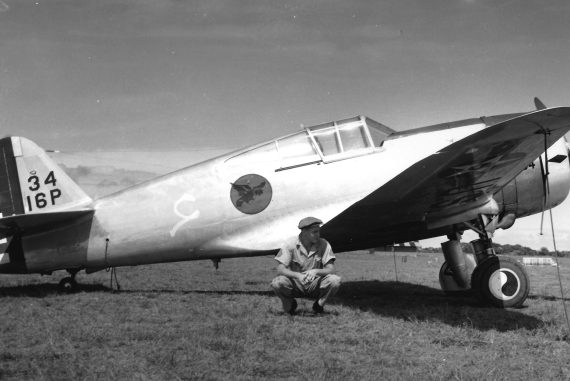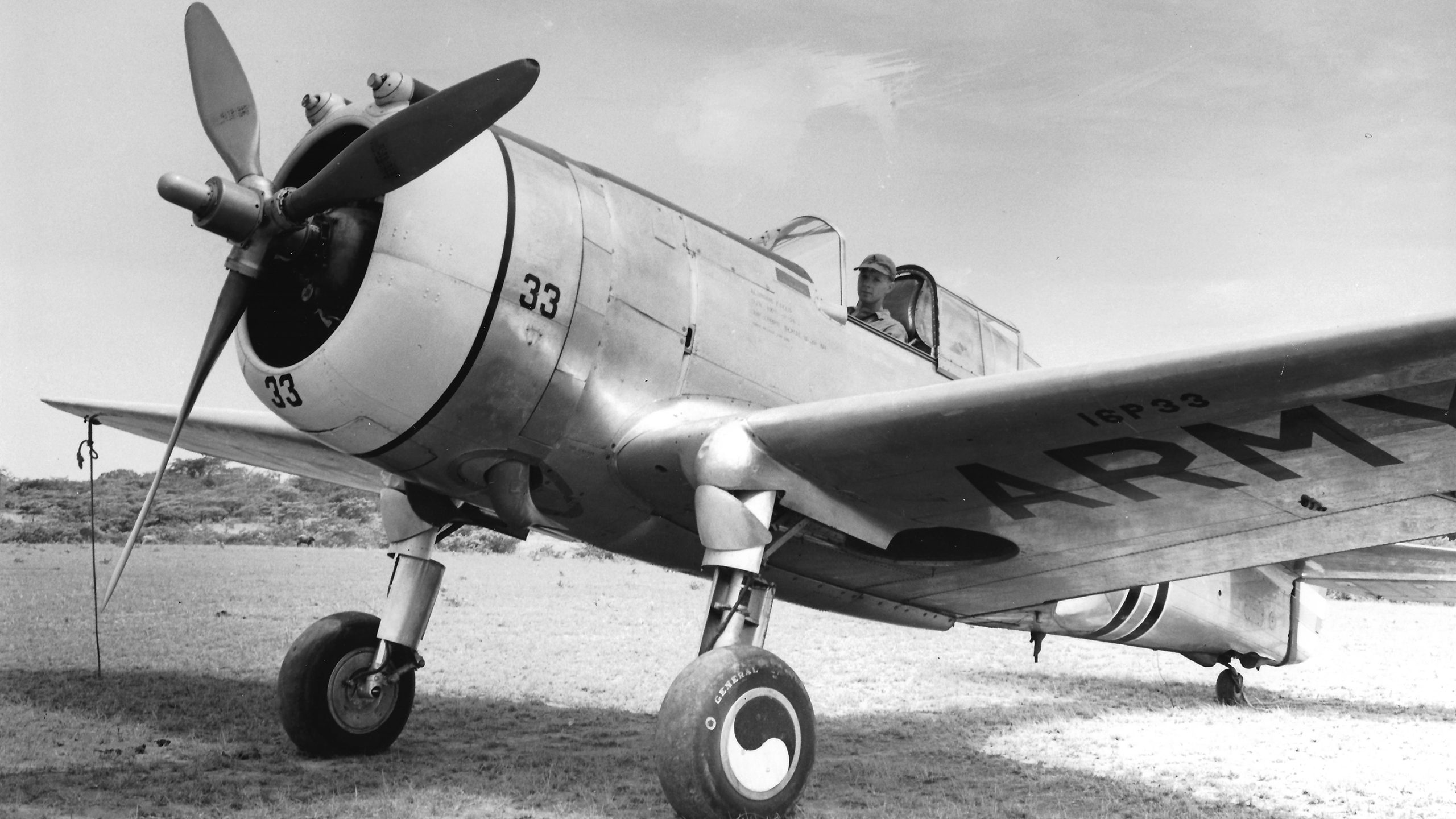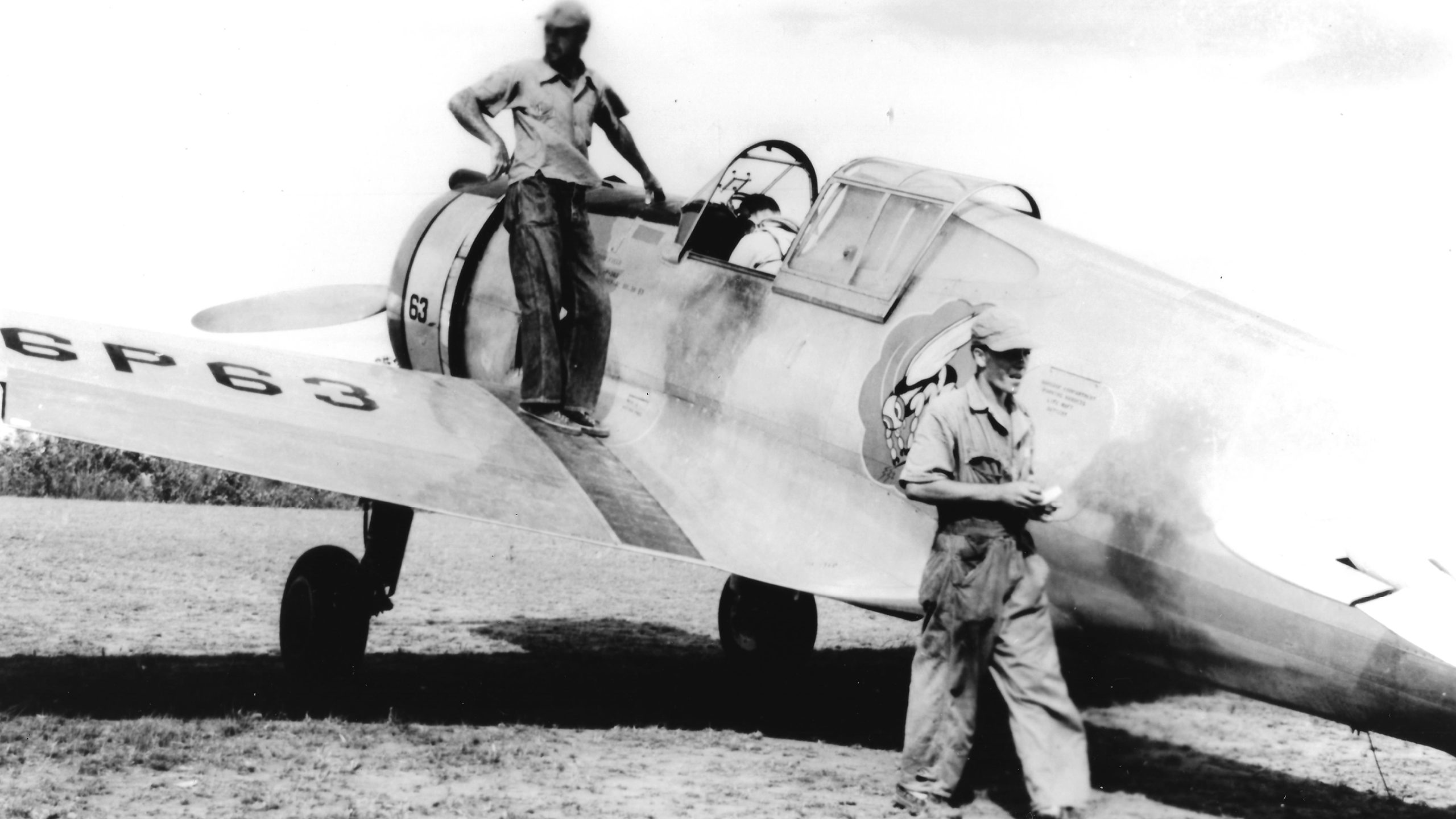Panama Canal Defenders – The Curtiss P-36A Hawk

As Germany invaded Poland in the Fall of 1939, the USAAC leadership set into motion a prearranged plan to reinforce its garrisons overseas, especially those in the vital Panama Canal.
The plan included the flight-delivery of 30 Curtiss P-36A Hawks, most of them levied from established units at Selfridge Field, Michigan – a number that the Air Corps sorely wished was larger but which, given its obligations to concurrently reinforce Hawaii, the West Coast, and equip a new unit for deployment to Alaska, was simply all that could be spared at the time.
Basically, the idea was to re-equip two full squadrons then in-being in the Canal Zone which were still equipped with a rather motley mix of venerable Boeing P-12E and P-12F biplanes, a type which had been in continuous service in the Canal Zone since 1930, and marginally more modern P-26A monoplanes, which had only just arrived in 1938.
Then, after the fall of France to the Nazi onslaught, the hard-pressed Air Corps dispatched one of the last nearly up-to-strength P-36A units left in the Continental United States, the Langley Field, Virginia based 36th Pursuit Group to reinforce a bare-bones patchwork of air bases that were being carved from the string of island that formed the Antilles from the Commonwealth of Puerto Rico south to Trinidad. Most arrived, after surprisingly incident-free flights, at the brand new Ponce Field on Puerto Rico January 18, 1941.The 36th PG took just 16 P-36As – all that they had, as they had lost several to state-side accidents before deploying – as equipment for its three very understrength Pursuit Squadrons, which operated alongside a few North American BC-1As sent for navigational training and a single Martin B-10BM as a target tug.
Thus, by the dawn of the fateful year 1941, the newly created Caribbean Air Force (CAC, the immediate lineal predecessor of Sixth Air Force), headquartered at Albrook Field in the Canal Zone, at least on paper, found itself with a combined total of three Pursuit Groups, two in Panama and one in the Antilles, every one of which was understrength, to provide the aerial defense for a truly vast area. To make matters worse, the two Groups in Panama were operating a mix of P-26As and P-36As and were being tasked to not only train pursuit pilots in operating over the trackless jungles, swamps and coastal areas of the isthmus, but to prepare crews for the transition to Bell P-39 and Curtiss P-40 fighters of more modern vintage which were promised and on the horizon.
Unlike the 36th PG’s deployment to Puerto Rico in early 1941, the flights to Panama from the Continental United States, usually in groups of three, did not go well for the relatively inexperienced pilots. Three of the P-36As, AC38-46, 38-47 and 38-49, having departed Selfridge Field and progressed in their journey as far as Las Mercedes Field in Managua, Nicaragua by September 4, 1939, had taken off late in the day for David, on the far Western fringe of the Republic of Panama, which was the jumping-off point for the last leg to Albrook Field, when they apparently encountered one of the late-afternoon massive tropical fronts which only those who have flown in the region can describe. The trio just disappeared and were totally unaccounted for quite some time.
When the Air Corps leadership in the Canal Zone was finally brought up to speed on the situation, two 44th Reconnaissance Squadron Douglas B-18s, two Northrop A-17s and a Grumman OA-9 were launched to David on the 5th to initiate a search and, aided by 17 P-36As which had already arrived at David and were awaiting clearance on to the Canal Zone, started scouring the entire area – with scant information on exactly where to search. They were joined by two venerable Thomas-Morse O-19Es of the 7th Reconnaissance Squadron the next day.
In short order, AC38-47, which had been flown by 2LT James A. Barnett (and which was still wearing its former Unit Number “73” at the time, as were all the other P-36As – they were not re-marked until after arrival at Albrook) was found on her belly at a beach on the Matapalo Peninsula on the Pacific Coast of Costa Rica. There was no sign of Lieutenant Barnett.
AC38-46, which had been flown by 2LT George F. Ranney and AC38-49, flown by Captain Harry A. Jenkins (although, for some reason, the Individual Aircraft Record card listed the pilot as 2LT George F. Ranney, an obvious corruption of the name of the pilot of AC38-46), were officially reported as “missing.”
Then, the crew of a Pan American Douglas DC-3 reported a P-36A about 18 miles Northwest of Cape Matapalo, and what they thought might be her pilot trudging along the beach, walking in the general direction of Madrigal, Costa Rica.
Another search aircraft spotted a third P-36A in the water off the beach from Madrigal. The crew of the intrepid Grumman OA-9 attempted an open-ocean landing near the floating wreckage, and was rewarded by being damaged for the effort, but managed to taxi ashore, where they found the very lucky Lieutenants Barnett and Ranney. Unfortunately, Captain Jenkins nor his aircraft – assumed to have been the one floating – were never found.

Thus, before they had even joined their units, the total number of P-36As which actually joined the CAC had already dropped from 30 to 27. Before their first four full months of service had ended, in December, CAC had lost eight more aircraft to accidents, at least three of them total losses as the pilots of the 24th Pursuit Squadron, which the CAC had planned to fully equip with the ‘new’ P-36’s, struggled to acquaint themselves with the retractable gear, high-performance aircraft – a bit more than an easy step-up from P-12s and P-26As.
As the P-36As were assimilated into the CAC, during the first month or two, they retained remnants of the stateside markings they had worn at Selfridge and Barksdale Fields. The Panama Air Depot (PAD, then at distant France Field, some 60 air miles from Albrook), as it received damaged aircraft for repair by way of barge or the Panama Railroad, assisted by efficiently removing the remnants of the stateside markings. However, as the CAC fighter establishment expanded rapidly, many of the P-36As were shuffled from squadron-to-squadron, and the hard-worked ground crews – most of whom were also new to the tropics and being at the very end of the Air Corps logistics chain of the day – rarely had what they needed, even in terms of proper paint colors or, frankly, truly accurate examples of unit insignia that they were being tasked to apply to the aircraft.
By June 1940, the understrength 43rd Pursuit Squadron had been passed some of the P-36As by the 24th PS and, by October, had also been joined by a few shunted over to the 28th PS with the 29th PS having acquired at least two by December.
Starting around July 1940, in view of the deteriorating world situation, the Air Corps finally issued guidance to its growing organizations to apply camouflage to legacy aircraft already in the inventory. Initially, unit identifiers and insignia were unchanged, but as the dark clouds of yet another world conflict loomed, the Air Corps started to direct the removal of any colors or markings which might detract from the value of camouflage.
In the Canal Zone and on Puerto Rico, these instructions arrived in fits and spurts, and the overseas commands were hard-pressed to not only comprehend exactly what was intended, but the actual wherewithal to carry the instructions out. In Panama, for example, it was found that not so much as a single gallon of the approved “Olive Drab” was to be found, and as a result, the PAD attempted to mix its own using interior paints that had been slated for painting latrines! Unit ground crews, to whom these instructions from on high were, at best, confusing, did the best they could to comply and, in the tropical environment in which they labored day-on-day, usually in the open, the results were predictably diverse. This undoubtedly contributed to some bizarre applications on P-36As, in some instances, having the “latrine paint” applied wit mops, as there was not enough to go around, and as a result the finished product appeared diluted.
By April 26, 1941, of the 27 P-36As that had made the trek from the CONUS in 1939, only 21 remained on the 16th Pursuit Group’s Order of Battle, and this had been reduced once again due to accidents – many of them landing accidents and “landing gear failures” – to just 17 by June 11th.
Meanwhile, the 16 P-36As of the Puerto Rico-based 36th Pursuit Group – not a single one of which ever reached the sky over the Panama Canal (they may as well have been in a different overseas air force) were, from mid-January 1941 on, having their own adventures. At least two of their prized aircraft were reluctantly surrendered to other units in the aircraft-poor Antilles, one going, for some reason, to the 27th Reconnaissance Squadron, while another was operated by the 24th Air Base Group at Borinquen Field, Puerto Rico, which was expanding rapidly. The Puerto Rican P-36’s that survived were probably amongst the last USAAC Hawks to receive ‘war paint’ as, while maintenance facilities in the distant canal Zone were sparse, in the Antilles they were virtually non-existent at this point.
To the relief of one and all, the 16th PG in Panama got word that they were to receive new Curtiss P-40B and P-40C fighters, as well as possibly Bell P-39Ds, and wasted no time in dispatching its 17 remaining, weary P-36As to the newly formed cadre of the 32nd Pursuit Group. When the P-40s did not arrive as promised, 14 of the P-36As were briefly returned to the 16th PG (less the 43rd PS), leaving the hapless 32nd PG with just two, as well as a smattering of ancient P-26As. Then, to exacerbate matters, CAC received instructions from none other than the Chief of the Air Corps to select the “best” 10 remaining P-36As (as well as two Douglas B-18s), overhaul them, and dispatch them to Fortaleza, Brazil – with experienced pilots and ground crew – to help cement the U.S. commitment to President Getulio Vargas to keep Brazil out of the Axis camp. Suddenly, there were a scant seven P-36As remaining in Sixth Air Force in Panama, with other still flying in the Antilles where, by December 1942, eight were still being operated routinely.

For its part, Sixth Air Force decided that the few remaining P-36As had some point defense value remaining and so dispatched all of them to what became known as the 16th Fighter Group Detachment (the 16th PG had been so redesignated during 1942) at the remote Salinas, Ecuador Air Base (APO 661), one of the two southernmost stations of the extremely long Guatemala City-Galapagos Islands-Talara, Peru (or Salinas, depending on weather) Pacific patrol arc, vital to the early warning system to defend the Canal from Japanese attempts.
Other Sixth Air Force units eventually acquired some of the Hawks although only individually or perhaps two, including HHS, 40th Bomb Group (1942), the 51st, 52nd and 53rd Pursuit Squadrons (1941-1942), the Panama Interceptor Command (PIC) Detachment at San Jose, Guatemala (1942, which also had the last of the P-26As), the 108th Reconnaissance Squadron (1943), and HHS, 6th Interceptor Command (1942).
Meanwhile, in the Antilles, the remnants of the P-36As which had been dispatched there in January 1941 were, remarkably, recalled to the CONUS between May 23-25, 1943, where they became fighter trainers in Texas.
The Sixth Air Force did not condemn and scrap its last RP-36A, AC38-37, until June 20, 1944, certainly a candidate for the longest serving of all USAAF P-36 Hawks.
None of the relatively small number of P-36Cs built went to the Caribbean.